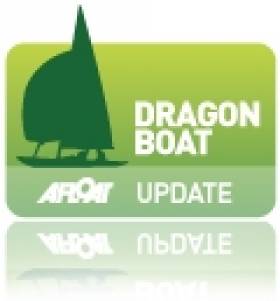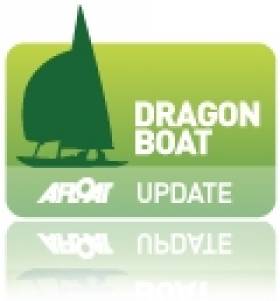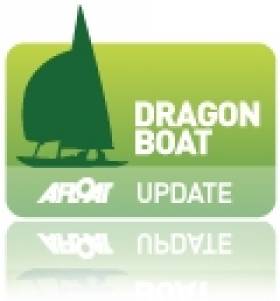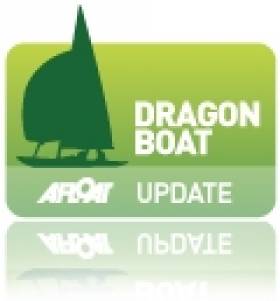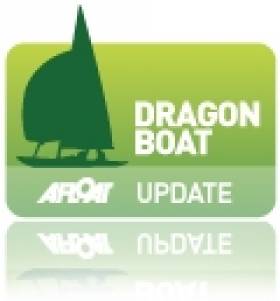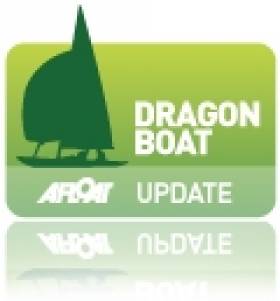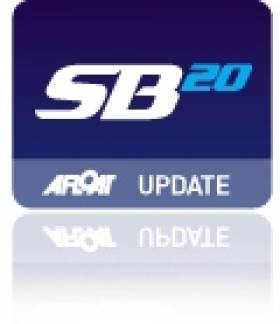Displaying items by tag: Dragon
Diederichs, Beadsworth & Lea Wins Dragon South Coasts
The International Dragon fleet's weeklong festival of sailing in Weymouth got off to a great, if slightly delayed, start today with the South Coast Championship. Originally scheduled to be sailed over two days, strong winds on Sunday had forced the Race Committee to keep the boats in harbour. Fortunately today the weather gods were smiling and the 37 strong fleet enjoyed three tightly fought races in shifty westerly winds of 15-20 knots.
Overall Klaus Diederichs, crewed by Andy Beadsworth and Jamie Lea, was top performer of the regatta with a neat 1, 3, 2 score line which gave them a 9 point overall lead and the South Coast Championship Trophy. Taking second place overall and claiming the Corinthian Trophy for amateur teams was Julia Bailey, crewed by Graham Bailey, Will Heritage and Keith Tippell, and the podium was completed by Rob Campbell, sailing with Justin and Tom Waples, who also took second place in the Corinthian division.
The opening race was to be a good indicator of things to come as Klaus Diederichs put their mark on the fleet leading Julia Bailey across the line with Gavia Wilkinson-Cox, crewed by Jean Sebastien Ponce and Vicente Pinheiro De Melo third and the Australian team of Marcus Blackmore, Terry Wetton and Don Cowie fourth.
Race two initially looked to be more of the same until the race committee responded to a right shift on the first run by moving the second weather mark correspondingly right. Unfortunately, just as the boats came round the leeward gate and the time window for further mark changes closed, the sea breeze kicked taking the wind hard left and leaving the second beat completely one sided. A number of boats lost out massively with some even having to crack off for the mark. Whilst others struggled to regain ground, Germany's Marcus Brennecke, crewed by Marc Pickel and Thomas Auracher, went on to win the race in style from Rob Campbell with Klaus Diederichs third, Julia Bailey fourth and David Atkinson, crewed by Ian Turnbull and John Outhwaite fifth.
With the sea breeze now firmly established the race committee set up for the third and final race which was to be a four beat marathon testing the sailors stamina as much as their sailing skills. After a somewhat lackluster performance in the opening two races of the event where he had finished 25 and 28, reigning European Champion Jose Matoso and his team of Gustavo Lima and Frederico Melo, finally found some form and led the fleet from the first mark to the finish. Behind him the battle for the remaining top five places was fierce with Klaus Diederichs eventually claiming second from Poul Richard Hoj-Jensen, crewed by Hamish McKay and Andrew Norden, with Gavia Wilkinson-Cox fourth and Grant Gordon, sailing with Ruaridh Scott and Joost Houweling, fifth.
At the prize giving there were a number of fun awards presented alongside the main trophies including awards for the top performance by a helm under 30 which went to Jono Brown, for the furthest travelled crew which was presented by Petticrows and won by Bocci Aoyama and his team from Japan, plus some special draw prizes present by event sponsor Zhik whose happy recipients went home with new shoes, sailing smocks and salopettes.
With the South Coast Championship completed the fleet now moves into the Edinburgh Cup, for the open British Championship, which will feature up to six races over the next four days. Weymouth will also play host to the 2013 Gazprom International Dragon World Championship from 5-13 September, and so the fleet will grow to 39 teams for the Edinburgh Cup as extra boats take advantage of this opportunity to not only challenge for the prestigious Edinburgh Cup, but also to train on the World Championship race area. Among those joining the fleet for the Edinburgh Cup are defending champion Simon Brien from Northern Ireland and reigning Dragon World Champion Lawrie Smith.
Overall Top Five
1 Klaus Diederichs, GBR758, Fever - 1,3,2 = 6pts
2 Julia Bailey, GBR720, Aimee - 2,4,9 = 15pts
3 Rob Campbell, GBR766, Quicksilver - 5,2,12 = 20pts
4 Marcus Blackmore, AUS227, Hooligan - 4,11,6 = 21pts
5 Chris Hunt, GBR768, Dark and Stormy - 7,7,8 = 22pts
Dragon World Championships Steer a Course for Weymouth
#dragon – Next week sees the Dragon Fleet descend on the Weymouth and Portland National Sailing Academy for the Dragon South Coast Championship on the 23 and 24 June, immediately followed by the Edinburgh Cup. Many teams will be using these events as a warm up for the highly anticipated Gazprom International Dragon World Championship in September, where the best of the fleet will be competing in the wake of Olympic Sailors.
The Dragon World Championship will attract the elite of international yacht racing; teams from 14 nationalities will be arriving at the National Sailing Academy, including many America's Cup, Olympic, World, Continental and National Champions. With a strict selection process, through a series of qualifying stages, only the very best crews will take part ensuring high competition for all.
The Sailing Academy will see one of the most beautiful and prestigious keelboat classes in the world with a fleet of more than 1400 boats in 26 countries, using the outstanding sailing facilities the area has to offer.
The Dragon fleet are ensured successful delivery of a world class event, with unrivalled shore side facilities, a dedicated event marina and race management teams fresh from the Olympic and Paralympic Games; the venue is truly world class.
Martin Makey, Chairman of the British Dragon Association commented, "Our international colleagues and our event supporter Gazprom International are convinced of the potential of the venue as well as the renowned reputation of Weymouth Bay to provide great racing. On many visits to WPNSA I have been most impressed with the development of the facilities and the quality of race management."
The Academy looks forward to welcoming the International Dragon Class for the Gazprom International Dragon World Championship, which will take place from the 5 -13th September at the Weymouth and Portland National Sailing Academy.
Craig Tops Dragons at Dublin Bay East Coast Event
#dragon – Royal St. George yacht Chimaera skippered by Andrew Craig was the winner of the weekend's East Coast Dragon Championship on Dublin Bay staged by the Royal Irish Yacht Club.
There were 12 entries with six races sailed and one discard. Scroll down for full results.
| Series Place | Sail No | Boat | Helm | Crew | Crew 2 | Club | Series Points |
| 1 | 216 | CHIMAERA | Andrew Craig | Brian Mathews | Mark Pettit | RStGYC | 9 |
| 2 | 201 | JAGUAR | Martin Byrne | Adam Winkelman | Maurice O'Connell | RStGYC | 14 |
| 3 | 211 | LITTLE FELLA | Cameron Good | Simon Furnes | Henry Kingston | KYC | 16 |
| 4 | 176 | PHANTOM | David Williams | Peter Bowring | Hillary Murray Williams | RStGYC | 21 |
| 5 | 210 | DIVA | Richard Goodbody | Rick Johnson | Rob Johnson | RIYC | 25 |
| 6 | 198 | DUBLIN BAY | Garry Treacy | Don O'Dowd | Jonathan O'Dowd | RStGYC | 29 |
| 7 | 127 | ZINZAN | Dan O'Connor | Tim Carpenter | Paul Moriarty | RIYC | 33 |
| 8 | 156 | MAR J | Adrian Bendon | E O'Mahony | Ben Fusco | KYC | 35 |
| 9 | 181 | SCORCHER | Peter O'Reilly | Mons Martensson | Joey Mason | RIYC | 37 |
| 10 | 206 | CLOUD | Clare Hogan | Michael Cotter | Ton Hogan | RStGYC | 42 |
| 11 | 161 | SIR OSSIS OF THE RIVER | Denis Bergin | Con Murphy | Ronan Murphy | RIYC | 43 |
| 12 | 159 | ZU | Chris Fleming | Iago De Santora | Matt Minch | RstGYC | 48 |
Dragons Announce World Championship Plans for Weymouth, UK
#dragon – The Notice of Race has been published and online entry is now open for the 2013 Dragon World Championship to be hosted by the Portland and Weymouth Sailing Academy from 5 to 13 September 2013. The event is open to teams who have qualified, either through the International Dragon World Ranking list or via qualification series held by each Dragon sailing nation. Full details of the qualification process are available form www.intdragon.net. As a result only the top Dragon sailors from each country are eligible to race ensuring competition of the very highest level.
The International Dragon fleet recently tested its metal at the 2013 BMW Cascais Dragon European Championship in Portugal where more than 60 Dragon sailors battled it out. Many of the teams from that regatta are also expected to compete in Weymouth including newly crowned Dragon European Champion Jose Matoso, German America's Cup star Markus Wieser, who came second, and Denmark's Jens Christensen who finished third. Teams will come from across the globe for the event and already Australia's Marcus Blackmore, sailing with Terry Wetton and Don Cowie, has confirmed his entry with several other Australian boats expected to join them.
As always the British will field a strong home team led by defending World Champion Lawrie Smith. Other names to watch out for from the British contingent are Klaus Diederichs, who just finished fourth at the Europeans; husband and wife team Graham and Julia Bailey, who finished sixth at the Europeans and will have their sights set on both overall and Corinthian (all amateur) victory; current Edinburgh Cup (British Open) Champion Simon Brien from Northern Ireland; and all round sailing legend Poul Richard Hoj-Jensen.
For those looking to train on the Worlds race area in advance of the event, the British Dragon Association will also be holding the 2013 South Coast Championship and the Edinburgh Cup, for the British Open Championship, at Weymouth. The South Coasts will run from 23 to 24 June and will be immediately followed by the Edinburgh Cup from 25 to 30 June 2013. The Edinburgh Cup is one of the most prestigious trophies in the International Dragon Class and always attracts a strong international entry as well as teams from across the UK and Ireland.
Danish Dragon Crew Lead at Euro Event, Cascais Portugal
#dragon – Denmark's Jorgen Schonherr/Jan Eli Gravad/Peter Blakskaer, "African Queen" is the first leader of the Cascais Dragon BMW European Championship 2013, which started yesterday in the Bay of Cascais. 62 Dragons from 16 countries were at the start for the first race but no Irish Dragon is competing.
It was a fantastic debut day with wind blowing from Wes at 9 knots.
The first and only race of the day was about two hours long and a tremendous battle for victory. Danes Jens Christensen/Kim Andersen/Anders Bagger, "Out of Bounce" and Britons Gavia Wilkinson-Cox/Mark Hart/Philip Catmur, "Jerboa" were at the front.
However, in the end, the victory was to the "African Queen", of Danes Jorgen Schonherr/Jan Eli Gravad/Peter Blakskaer. The British Gavia Wilkinson-Cox was second and Jens Christensen, third. "Seven Seas Too", Diogo Barros/Jorge Lima/Rúbrio Basílio, was the best Portuguese, finishing in an excellent 7th position.
The event has the high patronage of the Câmara Municipal de Cascais and BMW. Clube Naval de Cascais and the International Dragon Association are the organising authorities.
Cascais BMW Dragon European Championship 2013
Top Ten after one race
1º African Queen - Jorgen Schonherr - Dinamarca
2º Jerboa - Gavia Wilkinson-Cox – Grã-Bretanha
3º Out of Bounce - Jens Christensen - Dinamarca
4º Bunker Boys - Yevgen Braslavets - Ucrânia
5º Sophie III - Hugo Stenbeck - Suíça
6º Right Now - Alar Volmer - Estónia
7º Seven Seas Two - Diogo Barros - Portugal
8º Bunker Queen - Markus Wieser - Ucrânia
9º Hanni - Ferenk Kis-Szolgyemi - Hungria
10º Sui Generis - Ulli Libor – Alemanha
Overall after one race here
#dragon – The Irish Dragon class are kicking off the new season with a new Dublin Bay Sailing Club (DBSC) Sunday Olympic Racing schedule.
There are eight (8) DBSC Sunday Olympic racing events planned over the course of the season, with a focus on May and June.
The Dragon East Coast championships are being held in the RIYC 7-9 June, Nationals in the RUYC 8-11 August, the South Coasts in Glandore 31 Aug - 1 September, and the season's finale, the Jack Craig Memorial in Lough Derg 18-20 October.
Irish Dragon Team will Race for World Championship Honours in Weymouth
#dragon – The top Irish crews on the recently published Dragon ranking ladder will head for Weymouth and Portland National Sailing Academy (WPNSA), home of the sailing regattas of the 2012 Olympiad, for the 2013 Dragon World Championship from 5 to 13 September 2013. With its combination of great sailing waters, purpose built shore facilities, ease of access and fabulous Dorset location on the Jurassic Coast, Weymouth was the obvious choice when the British Dragon Association looked at potential venues.
"The Dragon World Championship attracts the elite of international yacht racing, from World and Continental Champions to America's Cup and Olympic veterans, so we need championship venues that can meet their very demanding requirements. We are delighted to be working in partnership with the WPNSA for this prestigious biennial event and are looking forward to an outstanding regatta." Explained British Dragon Association Chairman Martin Makey.
Since opening in 2000 WPNSA has established a well-deserved reputation for delivering outstanding events for both keelboats and dinghies. With unrivalled shore side facilities, a dedicated event marina and race management teams fresh from the Olympic and Paralympic Games it is a truly world-class venue.
Chris Knight, WPNSA Business Manager, noted "The planning of the Dragon events in Weymouth during 2013 is in full swing. We feel passionately about the Academy's ability to deliver on such world-class events and look forward to welcoming this celebrated keelboat class. "
Weymouth is not only a great venue for the sailors but also offers a host of attractions for friends and families too. With its wonderful clear air, sweeping cliff walks, breathtaking views and historic towns and villages brimming with restaurants and shops, Dorset is a visitor's paradise. The Jurassic Coast- a stunning stretch of 200 million-year-old shoreline that has been designated a Natural World Heritage Site by UNESCO - is on the doorstep and the Dorset countryside is an official Area of Outstanding Natural Beauty. There are great beaches for the kids to enjoy and plenty of fun attractions to keep them entertained .
Teams must qualify to take part in the Dragon World Championship and so only the very best sailors from each country will compete. Reigning World Champion Lawrie Smith, crewed by Ossie Stewart and Tim Tavinor, has confirmed he will defend his title. Amongst those expected to challenge are Russia's Dmitry Samokhin and Anatoly Loginov; Portugal's Jose Matoso; Germany's Tommy Mueller, Markus Wieser and Ulli Libor; Denmark's Lars Hendriksen, Jens Christensen and Joergen Schoenherr; Evgeny Braslavets from the Ukraine; Ireland's Martin Byrne and Simon Brien; Ben Van Cauwenbergh from Belgium; Ezio Gianni Murzi and Giuseppe Duca from Italy; Lowell and Phyllis Chang from Hong Kong and Richard Lynn from Australia. The British will field a very strong home team led by World Champion Lawrie Smith and including Klaus Diederichs, Ron James, Gavia Wilkinson-Cox and Graham and Julia Bailey.
For those keen to get in some advance training on the Worlds race area, the British Dragon Association will be holding the 2013 South Coast Championship and the Edinburgh Cup, for the British Open Championship, at Weymouth. The South Coasts will be held on 23 and 24 June and will be immediately followed by the Edinburgh Cup from 25 to 30 June 2013.
Byrne Tops Irish Dragon Class Rankings
#dragon – Dublin Bay's Martin Byrne leads the Irish Dragon class ranking list as the class prepares to divvy out limited places for Irish sailors intending to compete at the world and European class championships in 2013.
World or European championship places are allocated according to a ranking list (see xcel file for download below). The Irish fleet gets 8 places at a World or European Championship (plus one for a current Officer of the IDA). The system used for the past number of years allows sailors to count their best 3 results from the Easts, Nats, Souths and Derg in the calendar year before the Championship regatta.
Unfortunately, this year the East Coasts did not have the requisite number of races to count as a ranking regatta. After consultation with the International Dragon Association Irish officers decided to amend the ranking procedure this year to allow helmsmen to qualify for 2013 events (the Europeans in Cascais 6 – 13 April and the Worlds in Weymouth 5 – 13 September) counting their best three results from the Edinburgh Cup 2012, the Irish Nationals 2012, the Irish South Coasts 2012, the Gold Cup 2012 and the Jack Craig Memorial Bell in Derg 2012.
The attached Ranking List is calculated using the low point scoring system and only Irish Dragon Association members are included in the analysis.
Byrne, Shanks & Espey Win Dragon Event with Race to Spare
#dragon – The 2012 season saved the best for last for the Irish Dragon fleet. Ten crews enjoyed moderate breezes, warm sunshine, and sparkling flat water as they competed in Lough Derg YC's Freshwater One Design Keelboat Regatta. Martin Byrne, crewed by Anthony Shanks and Olympian James Espey, won the Jack Craig Memorial Bell with a race to spare with a tally of five firsts in the eight races sailed.
The fight behind was intense on the sprint courses expertly set by the LDYC team. Eventually Garry Treacy crewed by Paul Maguire and Don O'Dowd secured second place, with third place going to Richard Goodbody and Tim Pearson sharing the helm on Diva, and crewed by the Johnson brothers, Rick and Rob, and fourth taken by Maeve Cotter with sons Daniel and Sean.
Duncan Takes Lough Derg SB20 Event
#loughderg – Beautiful Autumn sunshine greeted the combined fleets of Dragons, SB20's, Squibs and J80's as they started the final day of the Lough Derg Yacht Club Freshwater Keelboat regatta. Not a ripple stirred Lough Derg as the fleet left the dock but the forecast South Easterly 10-20 knots soon made its appearance for race 1.
In the Dragon Class, Martin Byrne from RSGYC crewed by Anthony Shanks and James Espey stormed to a decisive victory counting five 1sts and two 3rds to win by a 12 point margin over RSGYC stablemates Gerry Treacy, Paul McGuire and Don O'Dowd. Byrne didn't have to race the final race in the series and left it up to the pack to decide second overall.
The SB20 class clearly enjoyed the fresh and gusty conditions on the trapezoid course today. It was neck and neck between rivals Ben Duncan and Peter Kennedy going into the final races but it was Duncan who scored a 1,3 today over Kennedy's 6,2 to win the midlands title for the first time in its 6 year history. Kennedy who has won this event for the past three years running had to contend himself with second. Third place had to be fought over today by Aidan O'Connell and James Gorman but the Black Flag that Aidan received for being over early in race 1, upset his chances and James took his podium result by a single point lead over Aidan in the end. O'Connell did manage to finish on a high by winning the final race of the series.
In the 2012 SB20 circuit Duncan has all but shown a clean set of results having only lost 1 event this year.
The squibs also shared the Windward/Leeward course today with the Dragons. No results were available last night due to protests but it was James Matthews from Kinsale who scored 3,1,3,1,3 to win over Jonathan Craig's very solid 1,4,2,4,2 Only two points separated the leaders in the end.
The J80's were given a lesson in consistency this weekend by Andrew Deacon who's lead was never in doubt. Scoring 1,1,1,1,1 and discarding a first to win by an 11 point margin over second place Hetty Sanders (5,4,3,2,2). Next on the podium was team "Cougars" helmed by Sue Smithwick and crewed by Adair Leech, Mary Hughes and Alison Smithwick who scored 4,5,2,3,2.
Dinner in the yacht club last night followed by a charity night in the Whiskey Still where Johnny Logan made a guest appearance, keeping the crews entertained.
PRO Claire Toohey and her team did a great job this weekend running the side by side courses. Lough Derg Yacht Club are past masters at this type of event and the combined classes look forward to keeping this an established part of their calendars.




























